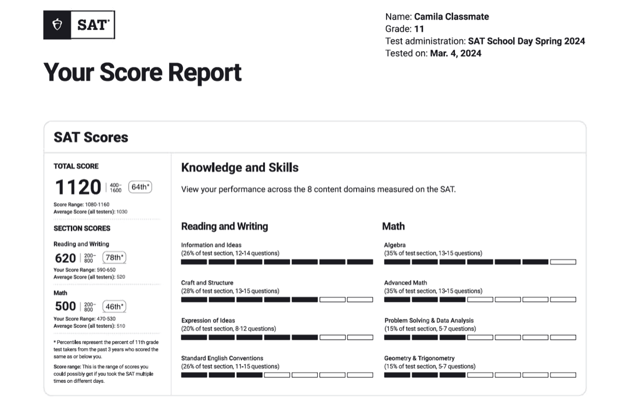You've made it! After months of preparation and planning, your teen has taken their first official SAT. Now, just thirteen days later, the moment arrives: The official score report has been released.
But what does it all mean? And where do you go from here? Here are five things you need to know to help you make sense of your SAT scores.1. Your score reflects more than just the number of correct answers.
Your total score is out of 1600, calculated by adding the Reading and Writing section score with the Math section score. The highest you can score in either section is 800.
The SAT calculates each section score by looking both at the number of questions you got right and how difficult they were, and then it converts that to a "scaled" score out of 800. For instance, if your teen got six questions wrong in the Math section, their scaled score could be anywhere from a 710 to a 740, depending on the difficulty level of the questions they got wrong.

2. Your score is only an estimation of your true ability.
If you look closely, you will see “Your Score Range” listed right below your total and section scores. And there is a good chance you are thinking, “I know exactly what my child got! Why do I need a range?”
Well, the truth of it is one day your teen might hit a string of lucky guesses; on another day they may make a string of careless mistakes. And they might get unlucky enough that those careless mistakes are made on those hard questions that are worth more points. Given that, you cannot really trust that a single result reflects a typical performance for your kid. But because extreme over- or under-performances are rare, it is reasonably safe to say that your teen could consistently score around that given score.
Now, will that score range matter to colleges? No. They’ll only care about the single total and section scores on your report. But if you’re looking at your teen’s score and wondering whether or not to take another shot at the test, do not let a lower-than-expected score discourage you or a higher-than-expected score make you overconfident. Performance over time on practice content will always be the best indicator of your teen’s true potential.
3. Review your score percentile to keep your score in perspective, but don’t rely on it to inform score submission as part of an application.
The score percentile tells you how your teen’s score compares with other testers over the last couple years. It's important to note that admissions officers don't look at percentiles, they focus on scores.
With this in mind, your score percentile is not actionable information, but it can be helpful to remember that top scores are rare and big gains involve surpassing a lot of other testers. For example, a 1090 is a 60th percentile score. A 60th percentile score indicates that 60 percent of recent testers scored at or below that score. While a 1090 may feel far away from the competitive scores top colleges require, it is actually already well ahead of most testers.
On the other hand, to jump from that 1090 to a 1290 (85th percentile score) requires jumping past 25 percent of other testers. And a score like 1400, still 200 points below a perfect score, is a 93rd percentile score. So if you tested alongside 1000 other testers, you would need to do better than 920 of them.
4. Your “Knowledge and Skills” scores can be misleading.
The “Knowledge and Skills” section of the report is there to give you a clearer picture of your teen’s strengths and weaknesses on the test. And to some extent, it does.
A low score on Standard English Conventions means that your teen needs help with grammar and punctuation, and a low score on Expression of Ideas tells us that your teen struggled with transition words or "rhetorical synthesis."
But the visuals accompanying each “content domain” can also be misleading. For example, because the SAT Math test has 13-15 Algebra questions but only 5-7 Geometry & Trigonometry questions, a low Geometry & Trigonometry score might indicate the same number of errors as a high Algebra score. Consequently, you need to be careful using those score bars to inform studying. It will often make more sense for most testers with low Geometry & Trig scores to focus energies on Algebra and Advanced Math instead, if those categories are not at perfect or near-perfect.
5. How "good" your score is depends on context.
So far we have pointed out that your score is not a perfectly reliable measure of your testing ability, that even modest gains in score can require large jumps across score percentiles, and that the lowest “content domain” results may not actually be the ones most in need of work. If one thing should be clear by now, it is that understanding SAT scores requires a lot of context.Determining whether a score is "good" requires knowing how you plan to use it. Are you using it for admission or merit aid? At a school that is test-optional, test flexible, or that requires testing? Does it meet or surpass the median score of applicants who get accepted at some or all of the colleges on your teen's list?
And determining the next steps requires contextual considerations: Was this a first attempt or a third? Was the test taken with prior preparation or not? Was it taken by a sophomore, junior, or senior?
Before you despair at a "weak" score or celebrate a "strong" one, figure out your context and evaluate your scores and next steps accordingly.
READ MORE: 10 Important Standardized Testing Terms You Need to Know
If any of this feels overwhelming, don’t worry! There are a lot of ways to get great guidance to help navigate this process. Start by looking up the middle 50% of test scores for admitted students at the colleges on the list. You can typically find this on a college's admissions website. Then, if it seems like a stronger score is worth working towards, seek out test prep experts who can provide insights on your teen’s test results and evaluate their potential for score growth.












